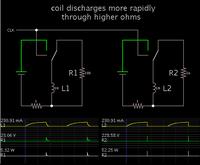mayd85
Junior Member level 3

Hi,
I have an inductive load (say, a relay or solenoid coil) and I know the R & L values of the coil and of course the source voltage with which I am driving the coil. I am driving it with a high side switch. The problem is that I do not have the actual load with me to measure any values. How can I calculate the back emf at time t=0 when the switch is made open?
I have an inductive load (say, a relay or solenoid coil) and I know the R & L values of the coil and of course the source voltage with which I am driving the coil. I am driving it with a high side switch. The problem is that I do not have the actual load with me to measure any values. How can I calculate the back emf at time t=0 when the switch is made open?




